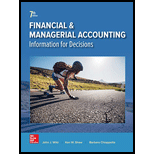
Concept explainers
1.
To identify: Break- even point of sales in dollars for each product.
1.
Explanation of Solution
Product BB
Given,
Fixed cost is $100,000.
Calculated values,
Contribution margin ratio is 20% or 0.2 (from working note).
Formula to calculate break-even point of sales in dollars,
Substitute $125,000 for fixed cost and 0.2 for contribution margin ratio.
Working note:
Calculation of selling price per unit,
Calculation of variable cost per unit,
Calculation of contribution margin ratio,
Hence, contribution margin ratio is 30%.
Product TT
Given,
Fixed cost is $560,000.
Calculated values,
Contribution margin ratio is 87.5% or 0.875 (from working note).
Formula to calculate break-even point of sales in dollars,
Substitute $560,000 for fixed cost and 0.875 for contribution margin ratio.
Working note:
Calculation of selling price per unit,
Calculation of variable cost per unit,
Calculation of contribution margin ratio,
Hence, contribution margin ratio is 87.5%.
Hence, break-even point of sale of Product BB is $625,000 and Product TT is $640,000.
2.
To prepare: A
2.
Explanation of Solution
Statement to show the contribution margin income statement,
| Company S | ||
| Income Statement | ||
| For the Year Ended December 31, 20XX | ||
| Particulars | Product BB Amount ($) | Product TT Amount ($) |
| Sales | 528,000 | 528,000 |
| Less: Variable Cost | 369,600 | 66,000 |
| Contribution Margin | 158,400 | 462,000 |
| Less: Fixed Cost | 100,000 | 560,000 |
| Pre Tax Income | 58,400 | (98,000) |
| Tax | 18,688 | (31,360) |
| Net Income | 39,712 | (66,640) |
Working note:
Given,
The numbers of units sold is 33,000.
The selling price is $16 of both products.
Variable cost per unit of Product BB is $11.20.
Variable cost per unit of Product TT is $2.
Calculation of total sales,
The total sales are $528,000.
Product BB
Calculation of total variable cost,
The total variable cost is $369,600.
Product TT
Calculation of total variable cost,
The total variable cost is $66,000.
Product BB
Calculation of tax,
`
Product TT
Calculation of tax,
`
Hence, the net income of Company S is $39,712 from Product BB and net loss $66,640 from Product TT.
3.
To prepare: A
3.
Explanation of Solution
Statement to show the contribution margin income statement
| Company S | ||
| Income Statement | ||
| For the Year Ended December 31, 20XX | ||
| Particulars | Product BB Amount ($) | Product TT Amount ($) |
| Sales | 1,024,000 | 1,024,000 |
| Less: Variable Cost | 716,800 | 128,000 |
| Contribution Margin | 307,200 | 896,000 |
| Less: Fixed Cost | 100,000 | 560,000 |
| Pre Tax Income | 207,200 | 336,000 |
| Tax | 66,304 | 107,520 |
| Net Income | 140,896 | 228,480 |
Table(2)
Working note:
Given,
The numbers of units sold is 64,000.
The selling price is $16 of both products.
Variable cost per unit of Product BB is $11.20.
Variable cost per unit of Product TT is $2.
Calculation of total sales,
The total sales are $1,024,000.
Product BB
Calculation of total variable cost,
The total variable cost is $716,800.
Product TT
Calculation of total variable cost,
The total variable cost is $128,000.
Product BB
Calculation of tax,
`
Product TT
Calculation of tax,
`
Hence, the net income of Company S is $140,896 from Product BB and $228,480 from Product TT.
4.
To identify: The product that would greatly experience loss when sales decreases.
4.
Explanation of Solution
- The Product TT will experience greater loss when sales decreases.
- Per unit variable cost is low of Product TT therefore, contribution is highly affected due to decrease in sales.
- Fixed cost is high of product TT therefore; when sales highly decrease the product TT have to suffer huge losses.
Hence, product that would greatly experience loss when sales decreases is product TT as its fixed expenses are higher.
5.
To identify: The factors that might have created the different cost structure for the two products.
5.
Explanation of Solution
The factors that might have created the different cost structure for the two products:
- Labor cost: It may affect the cost structure as it is one of the important parts of total cost it includes the wages paid to the workers.
- Machinery cost: It may affect the cost structure as it is one of the important parts of total cost it includes the cost incurred to install machinery.
- Salary of staff: It may affect the cost structure as it is one of the important parts of total cost it depends on the number of staff working in the organization.
- Raw material cost: It may affect the cost structure as it is one of the important parts of total cost, raw material required may be more or less costly therefore, it also affect a product’s cost.
Hence, raw material cost, salary structure, machinery required etc are the factors that might have created the different cost structure for the two products.
Want to see more full solutions like this?
Chapter 18 Solutions
Loose-Leaf for Financial and Managerial Accounting

 AccountingAccountingISBN:9781337272094Author:WARREN, Carl S., Reeve, James M., Duchac, Jonathan E.Publisher:Cengage Learning,
AccountingAccountingISBN:9781337272094Author:WARREN, Carl S., Reeve, James M., Duchac, Jonathan E.Publisher:Cengage Learning, Accounting Information SystemsAccountingISBN:9781337619202Author:Hall, James A.Publisher:Cengage Learning,
Accounting Information SystemsAccountingISBN:9781337619202Author:Hall, James A.Publisher:Cengage Learning, Horngren's Cost Accounting: A Managerial Emphasis...AccountingISBN:9780134475585Author:Srikant M. Datar, Madhav V. RajanPublisher:PEARSON
Horngren's Cost Accounting: A Managerial Emphasis...AccountingISBN:9780134475585Author:Srikant M. Datar, Madhav V. RajanPublisher:PEARSON Intermediate AccountingAccountingISBN:9781259722660Author:J. David Spiceland, Mark W. Nelson, Wayne M ThomasPublisher:McGraw-Hill Education
Intermediate AccountingAccountingISBN:9781259722660Author:J. David Spiceland, Mark W. Nelson, Wayne M ThomasPublisher:McGraw-Hill Education Financial and Managerial AccountingAccountingISBN:9781259726705Author:John J Wild, Ken W. Shaw, Barbara Chiappetta Fundamental Accounting PrinciplesPublisher:McGraw-Hill Education
Financial and Managerial AccountingAccountingISBN:9781259726705Author:John J Wild, Ken W. Shaw, Barbara Chiappetta Fundamental Accounting PrinciplesPublisher:McGraw-Hill Education





